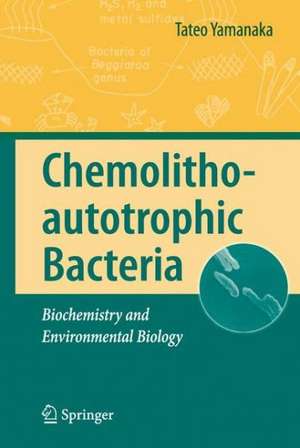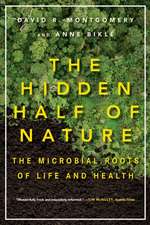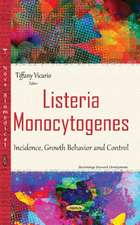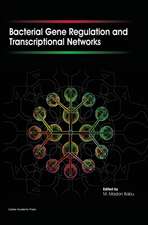Chemolithoautotrophic Bacteria: Biochemistry and Environmental Biology
Autor Tateo Yamanakaen Limba Engleză Paperback – 20 oct 2010
| Toate formatele și edițiile | Preț | Express |
|---|---|---|
| Paperback (1) | 911.73 lei 6-8 săpt. | |
| Springer – 20 oct 2010 | 911.73 lei 6-8 săpt. | |
| Hardback (1) | 917.09 lei 6-8 săpt. | |
| Springer – 24 iun 2008 | 917.09 lei 6-8 săpt. |
Preț: 911.73 lei
Preț vechi: 1111.86 lei
-18% Nou
Puncte Express: 1368
Preț estimativ în valută:
174.48€ • 182.97$ • 145.49£
174.48€ • 182.97$ • 145.49£
Carte tipărită la comandă
Livrare economică 07-21 ianuarie 25
Preluare comenzi: 021 569.72.76
Specificații
ISBN-13: 9784431998501
ISBN-10: 4431998500
Pagini: 172
Ilustrații: XIV, 157 p. 47 illus.
Dimensiuni: 155 x 235 x 9 mm
Greutate: 0.25 kg
Ediția:Softcover reprint of hardcover 1st ed. 2008
Editura: Springer
Colecția Springer
Locul publicării:Tokyo, Japan
ISBN-10: 4431998500
Pagini: 172
Ilustrații: XIV, 157 p. 47 illus.
Dimensiuni: 155 x 235 x 9 mm
Greutate: 0.25 kg
Ediția:Softcover reprint of hardcover 1st ed. 2008
Editura: Springer
Colecția Springer
Locul publicării:Tokyo, Japan
Public țintă
ResearchDescriere
Bacteria change the surface of the Earth. All kinds of bacteria reside in the biosphere, and although sometimes they may cause damage, they also help in cleaning the surface of the Earth and in the circulation of various substances. Chemolithoautotrophic bacteria in particular have a unique and intimate relationship with inorganic substances and human beings. This book covers in detail advances in the biochemistry and physiology of several chemolithoautotrophic bacteria as well as their relationship to certain environments. Included are recent findings regarding the oxidation mechanisms of ammonia, nitrite, sulfur compounds, and ferrous iron by special bacteria. The characteristics of many cytochromes are described to further advance the understanding of bacterial oxidation systems of inorganic compounds. Applications of bacteria, such as in sewage treatment and in biohydometallurgy, among others, are detailed, and bacteria considered closest to the origins of life are discussed in the final chapter.
Cuprins
Preface Abbreviations 1 General Considerations 1.1 Chemoheterotrophic Bacteria 1.2 Chemolithoautotrophic Bacteria 2 Cytochromes 2.1 Hemes 2.2 Kinds of Cytochromes 3 Nitrogen Circulation on Earth and Bacteria 3.1 Bacterial Nitrifi cation 3.2 Applications of Nitrifying Bacteria 3.3 Interaction Between Ammonia-Oxidizing and Nitrite-Oxidizing Bacteria 3.4 Reduction of Nitrate and Nitrogen Gas 4 Sulfur Circulation on Earth and Bacteria 4.1 Bacteria Forming Hydrogen Sulfide 4.2 Sulfur-Oxidizing Bacteria 5 Oxidation and Reduction of Iron by Bacteria 5.1 Bacteria That Oxidize or Reduce Iron 5.2 Applications of Iron-Oxidizing Bacteria 5.3 Upheaval of House Foundations: Damage Caused by Bacteria 6 Carbon Circulation on Earth and Microorganisms 6.1 Mechanisms of Formation of Organic Compounds from Carbon Dioxide 6.2 Methanogens 6.3 Bacteria Utilizing Carbon Monoxide 7 Organisms Evolutionarily Closest to the Origin of Life 7.1 Archaea and Their Energy-Acquiring Reactions 7.2 Biological Evolution at Earlier Stages References Index
Textul de pe ultima copertă
Bacteria change the surface of the Earth. All kinds of bacteria reside in the biosphere, and although sometimes they may cause damage, they also help in cleaning the surface of the Earth and in the circulation of various substances. Chemolithoautotrophic bacteria in particular have a unique and intimate relationship with inorganic substances and human beings.
This book covers in detail advances in the biochemistry and physiology of several chemolithoautotrophic bacteria as well as their relationship to certain environments. Included are recent findings regarding the oxidation mechanisms of ammonia, nitrite, sulfur compounds, and ferrous iron by special bacteria. The characteristics of many cytochromes are described to further advance the understanding of bacterial oxidation systems of inorganic compounds. Applications of bacteria, such as in sewage treatment and in biohydometallurgy, among others, are detailed, and bacteria considered closest to the origins of life are discussed in the final chapter.
This book covers in detail advances in the biochemistry and physiology of several chemolithoautotrophic bacteria as well as their relationship to certain environments. Included are recent findings regarding the oxidation mechanisms of ammonia, nitrite, sulfur compounds, and ferrous iron by special bacteria. The characteristics of many cytochromes are described to further advance the understanding of bacterial oxidation systems of inorganic compounds. Applications of bacteria, such as in sewage treatment and in biohydometallurgy, among others, are detailed, and bacteria considered closest to the origins of life are discussed in the final chapter.
Caracteristici
Unique schemefor summarizing energy metabolism in bacteria.
Explanation of how human life is linked to the Earth by chemolithoautotrophic bacteria.
Explanation of how human life is linked to the Earth by chemolithoautotrophic bacteria.









